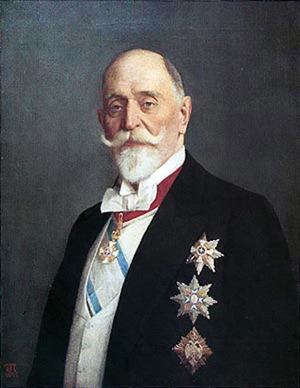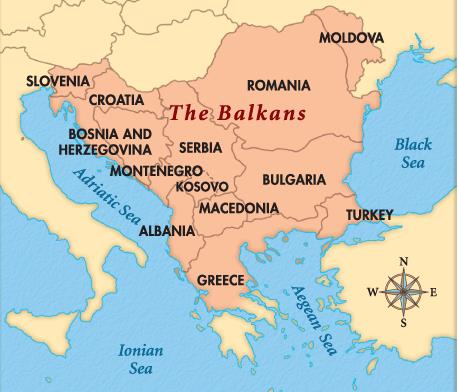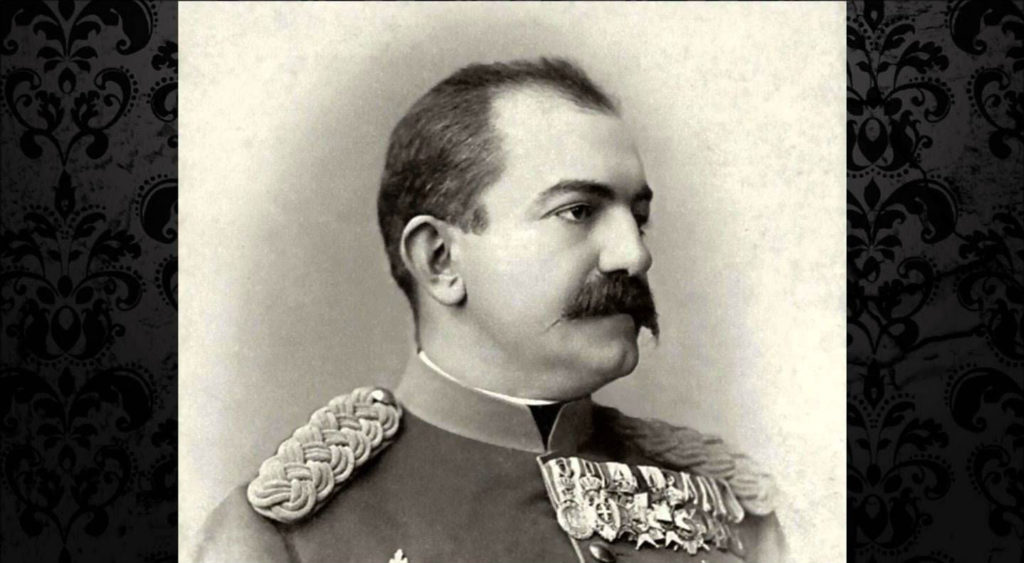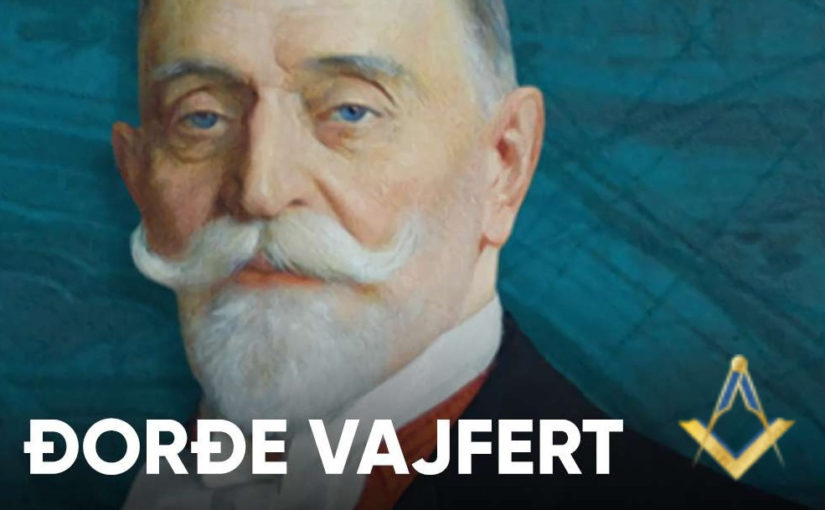George Weifert – Djordje Vaifert (1850-1937) – is arguably the most distinguished promoter of Serbian Freemasonry. His Masonic career, spanning some forty-seven years (1890-1937), is the story of the beginnings of Serbian and Yugoslavian Freemasonry, of its growth and of the turbulent times in which it existed.
Weifert was the first Master of one of the original Lodges in Serbia[1], Sovereign Grand Commander of the Supreme Council of Serbia[2], Grand Master of the Grand Lodge of Serbs, Croats and Slovenians-Yugoslavia (Velika Loza Srba, Hrvata/Slovenaca-Jugoslavija)[3], from its founding in 1919 till 1933, and a Sovereign Grand Commander of the Supreme Council of Yugoslavia Ancient and Accepted Scottish Rite from 1919 till 1937[4].
During Weifert’s time, the Balkan Peninsula was a hotbed of religious, ethnic, and political conflict, as indeed it still is today, and in which everybody seemed to be involved. Many members of the Craft held eminent positions in political, economical and cultural life. Many of them often failed to distinguish between their professional obligations, patriotic duty and Masonic activity. This made Freemasonry in Serbia an easy target for anti-Masonic propaganda. George Weifert recognized this problem early on. As a leader in Serbian Freemasonry, he always insisted on keeping religion and politics separate from the Craft and out of the lodge, despite the fact that this was to prove an almost impossible task.
Let us but examine Weifert’s history and we will see that he was a true builder, a man of vision, an example of a freemason who lived what he taught, and a true ‘pillar’ of Freemasonry.
HIS EARLY YEARS
Weifert was born in Pancevo on 15 June 1850. His father and mother – Ignjat and Ana Weifert – were both German, Catholic and citizens of Hungary, which was at that time a part of the Austro-Hungarian Empire[5]. Pancevo was a small Hungarian border town on the banks of the river Danube, populated with a mix of German, Hungarian and Serbian merchants and artisans. On the opposite bank of the Danube stood Belgrade the commercial centre and capital of the newly emerging kingdom of Serbia, at that time still formally a part of the dying Ottoman Empire[6].
Weifert’s grandfather moved to Pancevo in the beginning of the 19th century, trying his luck first as a wheat merchant and then as a brewer of beer. In order to improve his business he sent his son Ignjat to Munich, where he spent time working and studying beer production in the famous Spatenbrau Brewery. Upon his return home, Ignjat Weifert and his father built the largest brewery in Pancevo, still in existence today[7]. In 1865 they rented an existing brewery [8] in Belgrade, and started production there in order to avoid the cost of transporting the beer from Pancevo to Belgrade.

Young Weifert attended the German Elementary School and the Hungarian High School in Pancevo, after which his father sent him to Budapest, where in 1869 he graduated from the Merchants Academy. In accordance with the family business needs, he then attended the Agricultural School in Weihenstofen, near Munich, where he concentrated his studies on beer production technology. After graduation in 1872 he returned to Belgrade, in order to help with his father’s rapidly growing business.

Together they built a new brewery in the Topcidersko Brdo district of Belgrade[9]. In 1873 he married Maria Gisner. He was a bright young man on the threshold of an unusual and colorful career.
ENTREPRENEUR AND BANKER
On his return to Belgrade, he noticed that one of the biggest problems for his father’s brewery was a dependence on expensive coal which the brewery used in large quantities.
He started to search around Serbia, which is rich in coal deposits, for a place profitable for exploitation. After just one year, in 1873, he was given a concession to a coal mine in Kostolac, in Eastern Serbia on the river Danube. This was a great success: the mine was rich and he was able to transport the coal in barges up the Danube. This “beginner’s luck” stirred a passion for mining in him, that remained with him throughout his life and which became his main occupation.
In the following years he opened up numerous mines[10] in Serbia, but they proved largely to be financial disasters. By 1895, most of his business partners and investors had left him, and he had accumulated debts that neither his mine in Kostolac, nor his father’s brewery, could cover.
In 1895, he started to dig around Bor[11] and after initial disappointments his mining engineers struck lucky. This location proved to have the richest deposit of copper in Europe. In just a couple of years the small village of Bor became a large mining town and Weifert, by now the richest man in Serbia, was referred to as “the father of mining industry”.
This financial success enabled him to enlarge his brewing company. He opened up breweries in Sremska Mitrovica and Nis, and “Weifert’s beer” became the most popular in Serbia.
In 1867, Serbia gained independence from Turkey. The new state was in need of commercial and financial institutions to support the industrialization of this impoverished country, Weifert, who became a Serbian citizen in 1873, played a part in this endeavor. In 1880, he was one of the founders of the Serbian Chamber of Commerce and its first president. In 1884, against the wishes of King Milan Obrenovic’s government, which favoured foreign capital, Weifert and a group of Serbian investors met the requirements for establishing the National Bank of Serbia, and was elected its first Governor, a position he was to hold until 1926. His efforts were instrumental in transforming the National Bank of Serbia into a National Bank of Serbs, Croats and Slovenians after unification in 1919, and in stabilizing the dinar as a currency in Europe. As an entrepreneur he was, in many ways, ahead of his time.

Around his mines he would build worker’s housing, schools, hospitals, churches and mills. He was the first proprietor in Serbia to pay “sick days” to workers and to financially support the families of disabled workers. He significantly improved the infrastructure in Serbia, by building roads and railroads connecting his mines to the major ports and commercial centers. In his own words, he was always: “…trying to establish a relationship between the employer and the employee as that of an extended family.’[12]
PATRIOT AND PHILANTHROPIST
Arriving in Belgrade in 1872, young George Weifert took an active part in the public life of the newly established Kingdom of Serbia. In the year before the Serbian – Turkish war of 1876-78 broke out, he donated funds to purchase the first canons for the artillery battery of the Serbian army. During that war he volunteered and was enlisted into the cavalry. He distinguished himself by carrying messages between units on the front lines, under enemy fire. For his courage, he was awarded a “medal for bravery”. Upon his death in 1937, in accordance with his will, of all the awards and jewels that this great man received in his lifetime, this medal was the only jewel placed in his coffin.
Not being a member of any political party in Serbia, he always served as a person of compromise and balance in the turbulent political life of the new state. Following the armed revolt against the King, Milan Obrenovic, in 1883, in the Timok region of Serbia, referred to as the Timok Rebellion (Timocka buna), a number of politicians were arrested for treason and faced the death penalty. Weifert, in a potentially dangerous audience with the King, pleaded for their lives, and convinced the temperamental king to commute their death penalty to a prison sentence, thereby preventing further bloodshed in the flammable region of Timok.
ln 1893, he became one of the founders of ‘The King Stephan Dechanski (Kralj Stevan Decamski) Society for the education of deaf children, the purpose of which was to provide home and schooling for them. Throughout his life he was one the major benefactors of this society and also its honorary president.

In 1903, when in the military coup against the Obrenovich Dynasty, King Aleksandar Obrenovic and his wife Draga Masin were brutally murdered, and a new Karageorgevic Dynasty (Karadjordjevic) came to power, Weifert gave financial support to the families of the army officers killed during the coup. Years later, this action would prompt some historians to classify him as a civilian supporter of the coup itself. Weifert’s answer to such accusations was simply:
“No, I just helped those poor families of soldiers who died for what they believed in.”[13] During the First Balkan War of 1912, he paid for 60,000 loaves of bread, which were distributed from the Masonic Temple to the poor families in Belgrade during this time of privation. In this war the Serbian army captured a large number of Turkish officers and soldiers. Some of these prisoners of War were freemasons. George Weifert pleaded with Serbian authorities on their behalf, and as a result, the Turkish freemasons were released and sent home. Immediately after the war he established the ‘St. George Fund’ to provide financial assistance to war veterans. At the beginning of the First World War in 1915, Serbia was occupied by the Germans. During the war years Weifert lived in the South of France, where he organized humanitarian help for the people of occupied Serbia. After the war he returned to Belgrade to help in rebuilding the country which had been destroyed by the fleeing German forces. In 1929, Weifert, together with the ‘Edinburgh Council of Scottish Women’, and “The London Council of Scottish Women’, funded the building of the “Hospital for Women and Children’ in Belgrade.”[14] He also donated a piece of land for the construction of the headquarters of the “Belgrade Women’s Society” [15](Beogradsko Zensko Drusivo). Among many other philanthropic endeavours, one might mention large financial donation made towards the construction of the Serbian Academy of Science and Arts. Weifert was also a passionate antique and coin collector. In 1931, he donated his collection of antiques to the Museum of the City of Belgrade, and his valuable coin collection, consisting of 14,000 ancient Greek and Roman coins, to the University of Belgrade, but the most impressive of his legacies was the building of two churches: “St. Anna”, a Roman Catholic church in his birth place of Pancevo, and “St. George”, an Orthodox Christian church in Bor. On his death in 1937, the Catholic Bishop of Pancevo denied him the right to be buried in the churchyard he himself had built, because he was known to be a freemason. In 1923, on the occasion of celebrations to commemorate the commencement of his professional, and public work, as well as his fiftieth wedding anniversary, he announced his retirement from all duties, with the exception of that of Grand Master of the Grand Lodge Jugoslavia. In 1933, under pressure from his brethren he finally relinquished this role. His will was executed while he was still alive in accordance with his wishes. His enormous wealth was left to his wife Maria, and to his oldest nephew Dr Ferdinand Gramberg, who was the chief executive officer of all Weifert’s business enterprises. When George Weifert died on the 12 January 1937, he owned nothing but a pocket watch on golden chain, decorated with Masonic symbols, and a single diamond tie pin.”[16]
by Bro Stevan Nikolíc
SOURCE: Transaction of QQL , Vol 116 , Year 2003 , pages 201-204
NOTES
[1] Weifert was the First Worshipful Master of the Lodge Pobratim in Belgrade from 1891 to 1899.
[2] Weifert was the Sovereign Commander of the Supreme Council of Serbia from 1912 to 1919.
[3] The Grand Lodge of Serbs, Croats and Slovenians – Yugoslavia, changed its name to the Grand Lodge Yugoslavia in 1929.
[4] The Supreme Council of Serbia changed its name to the Supreme Council of Yugoslavia in 1919.
[5] The town of Pancevo is located on the River Danube, in Vojvodina, which is a southern part of the Pannonian Valley until 1919, the province of Vojvodina was part of Hungary. After the First World War it became part of the Kingdom of Serbs, Croats and Slovenians – Yugoslavia.
[6] The Kingdom of Serbia lost its independence after the battle of Kosovo in 1389, and became part of Ottoman Empire. After rebellions against Turks in 1804 and 1813, they gained partial autonomy. They finally achieved independence in 1867, under King Michael Obrenovich.
[7] After the Second World War, the brewery “Pancevo” was nationalized by the communist govemment. In spite of their mismanagement, Pancevo beer, as it is called today, is one of the most popular beers in Serbia.
[8] The German entrepreneur Wainhapel operated the brewery in Belgrade till 1865, but then went out of business.
[9] This brewery was destroyed during the German bombing of Belgrade on 6 April 1941.
[10] Weifert opened up eleven mines in total. Among them was a mercury mine on Avala (mountain near Belgrade) in 1882, a lead mine in Ruplje, and a gold mine in Rucmalne.
[11] Bor is a town in the South-East of Serbia, close to the border with Bulgaria.
[12] Magazine Shesrar Nos.4-6, (1937), p. 93, article by Z. Nesic.
[13] Nenezic D. Zoran, Masoni u Jugaslavíji’ 1764-1999 (Beograd, 1999), vol. 1, p. 282.
[14] Lazarevich Jelena British Women in Serbia (Belgrade, 1929), pp. 231-232. The Edinburgh Council of Scottish Women initiated work on construction of the hospital for women and children on the lot that belonged to the Women’s Medical Association of Belgrade’, as a “monument to the friendship and love of British people for Serbian Nation”. Because of the lack of funds they were joined in this project by the London Council of Scottish Women and George Weifert.
[15] Archives of the city of Belgrade, TD, Building dept. F-H-9-1930, file I-165-1942.
[16] Archives of the City of Belgrade, Credit information file, No. 16015; 1937.
- Influencia de la Masonería en Chile - April 29, 2024
- Pomegranate in Freemasonry – its significance - March 11, 2024
- Inns and Innkeepers’ incidence in Freemasonry expansion - February 28, 2024

